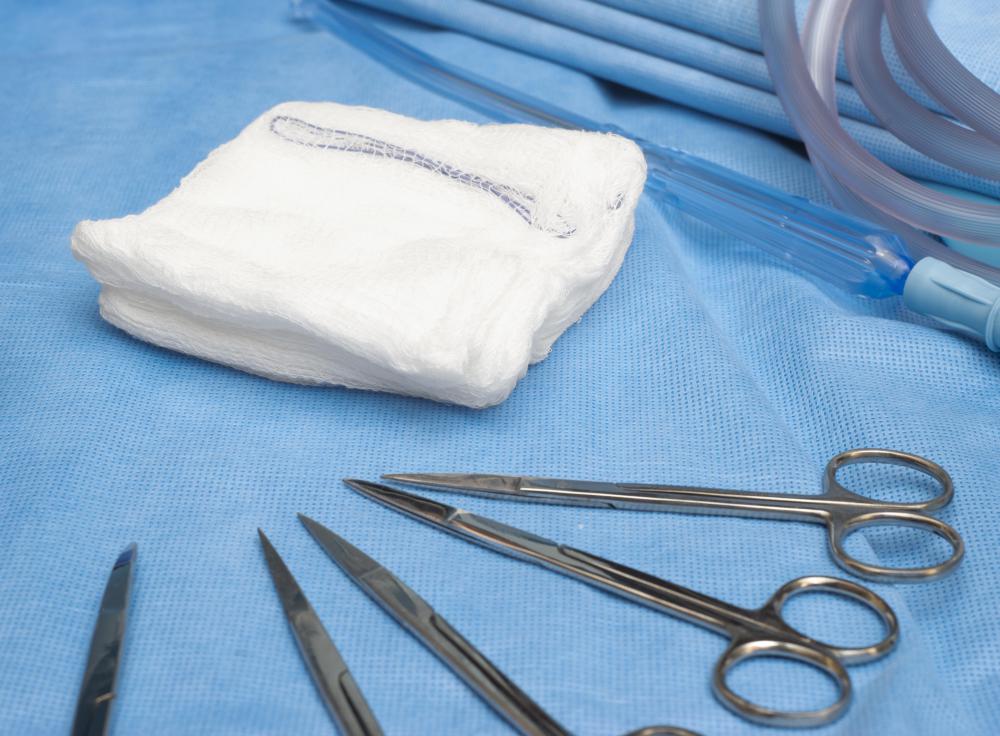At TheHealthBoard, we're committed to delivering accurate, trustworthy information. Our expert-authored content is rigorously fact-checked and sourced from credible authorities. Discover how we uphold the highest standards in providing you with reliable knowledge.
What is a Surgical Sponge?
A surgical sponge is a specialized sponge or pad used in surgery. Also known as a lap sponge, a surgical sponge is used to absorb liquids from a surgical site. It may be used in combination with suction to keep a surgical site clear, by a surgeon working to control bleeding, and in a number of other applications. Like other things used in surgery, sponges are designed to be sterile; they come in their own sterile packaging and can be safely autoclaved. They are generally disposable and discarded after surgery in biohzard containers which hold other disposable surgical instruments and equipment.
The surgical sponge carries a legendary status among people who are worried about objects being left inside patients during surgery. In fact, the sponge has such a lengthy history of ending up on the wrong side of the stitches after a surgery that there's even a special term for a situation in which a surgical sponge is left inside a patient: gossypiboma. Sponges are left behind for a variety of reasons, ranging from small sizes which allow some sponges to slip into a hidden area, to a surgery performed in an emergency, when the surgeon and the surgical team may be more worried about getting the patient through the surgery than anything else.

There are several techniques which can be used to control surgical sponges to reduce the risk of being left in the patient. The simplest involves counting all sponges and instruments, sometimes with the assistance of a barcode scanner. In this case, everything is counted or scanned in before the surgery, and counted or scanned out afterwards. This allows the surgical team to identify missing instruments and sponges immediately.

Many manufacturers embed a strip of radio-opaque material into every sponge they produce. This means that if a sponge is left in the body, an x-ray machine can be used to identify the sponge and pinpoint the location so it can be removed. This system is not foolproof, however, as sometimes the strip may be hidden behind a structure such as a bone, rendering the sponge effectively invisible.

Other technology designed to prevent the dreaded retained surgical sponge includes the addition of an RFID tag to each sponge. The tag can alert the surgical team when a sponge is left inside a patient, and can also be used when sponges and tools are counted out after a procedure.
AS FEATURED ON:
AS FEATURED ON:













Discussion Comments
I am pretty sure this happened to me. I had my third C-section five months ago and have been suffering ever since with infections. My first and last c sections were emergency procedures and this last one was very tense with my uterus and bladder both rupturing during surgery. Can you share with me some of the symptoms you had? I would appreciate it so much! Thanks!
I have a surgical sponge left inside of me and am having the hardest time getting a surgeon to help me. It was left during an emergency c-section over seven years ago and i have developed many symptoms and health issues because of it. This is a very serious and under reported condition. Medicine as we know it and how we deal with it needs to be changed. There is nothing in place for when this happens and it wasn't discovered during the delivery. Can anyone help? --mdelmastro
@Mor - As well as trying to establish a rapport with your surgeon, and your anesthesiologist who will also often and come see the patient before surgery, you should simply make sure they have a policy of doing a surgical sponge count.
It seems like common sense to do this, but some hospitals didn't have it down as a procedure.
More likely they would assign a person, often a scrub nurse, to be in charge of the surgical supplies and expect them to come up with their own way of accounting for everything.
Instead of ticking off each thing, each time, they'd just get this person to affirm there was nothing left behind. So, unless something was discovered later, there were no checkups.
Now, most hospitals are starting to put more rigorous checks into place. But, it is still worth asking them how they go about counting the sponges.
pleonasm - This is one more reason why you should try, if at all possible, to build a relationship with your surgeon. Even if it is only in a small way. If they see you as more of a human being and less as "my 2 o'clock appointment" they will be even more careful than usual in the surgery.
They will usually come and see you before in order to answer any questions. Don't be meek. Try to ask them anything that worries you. Tell them about your children or your parents.
I know doctors should care about all their patients, but you're right, surgeons can operate on several people every day, which can make it hard to stay sharp and disciplined on each one. This can help them to make more of an effort on you.
There have been quite a few episodes on medical shows where a patient discovers that they have had a surgical sponge left inside them. Usually they only discover it years after the fact, and have perhaps suffered for all that time.
Often these shows mine real life stories for their scripts so it doesn't surprise me that there is a technical term for leaving a sponge inside a patient!
It seems like the very worst thing a doctor or nurse could do. But, when you think about it, they do hundreds of medical procedures a year. In the case of quick ones like appendectomies, it may be more like thousands.
So, that means tens of thousands of surgical supplies to keep track of. I'm not saying it should happen, but I can definitely understand why it sometimes does happen.
Post your comments